When targeting estuary species like barramundi and mangrove jacks, one of the most popular techniques is to find a snag-ridden, mangrove-lined creek bank and begin peppering it with lures in the hope it may hold a hungry fish.
While this approach may bring results, having the ability to pick a ‘fishy’ snag from a ‘dud’ snag is a much better way to maximise your time on the water and ultimately catch more fish. While there is no perfect recipe for identifying fish holding snags, there are a few variables you can consider when choosing at which structure to throw your lures.
One of the first variables to consider is whether the structure is submerged over all tides. Some snags scream fish at high tide due to increased water levels, however during times of low water it may see either little water depth or be covered with no water at all. This is valuable information, as species like mangrove jack prefer all tide structure and they tend to hold on a snag and not move around too much. Therefore, if you are chasing jacks, a snag that only sees water on the top hours of the high tide may not be the best option. In contrast, a snag which provides cover over high and low tide will prove the ideal setting to target these feisty red fish. The reason for this is that jacks are ambush predators and very rarely seek out their food. They are more inclined to wait behind a thicket of submerged mangrove or fallen timber, waiting for fish to swim past before dealing their crimson death knell. Keeping this in mind, when chasing jacks, it is a lot easier to snare one from their ambush spot when water levels are lower as it drains the snag of underwater surface area. This will condense the jacks on the snag and make it much easier for fisherman to achieve not just one capture, but multiple captures from the same structure. The only thing better than catching one jack on lure is catching another one on the very next cast.
Barramundi on the other hand are notorious for moving around on the ebb and flow of the tide and these chrome beasts will frequently move up into snags as they go under with the rising tide. This is valuable knowledge when targeting barra, as certain structure can be left to later in the lure fishing session when water rises to suitable depths to provide adequate coverage. The difference between multiple captures and just one on a tide-affected snag can sometimes be a matter of half a metre. Knowing this can see a good session turn great.
To take this even further, when tides begin moving into spring or flood levels, estuaries and creeks begin to see water levels increase dramatically, sometimes adding more than a metre of water to structure. This is a prime time for lure fishermen to target exposed headlands that often exist on the outsides of creeks and estuaries. These headlands are mostly made up of a smattering of sandy beaches and most importantly, mangroves and timber snags. These mangroves and timber snags are for the most part of their lives only partly submerged, however on spring and flood tides they can soon become completely submerged, creating new habitats for fish and lure fishing opportunities for fishermen. Some of the more renowned spots, which resemble this scenario, include the areas around Cape Cleveland in Townsville, which regularly produce metre plus barramundi for lure fisherman during these conditions. Personally, I love these areas on these tides as they offer some amazing structure to fish, often in less than a metre of water, and that makes for some amazing surface fishing action.
If you are beginning to visualise a spot that resembles this, then take heed of the following advice. Be patient and don’t go peppering lures around these snag ridden headlands on the first king tide. King tides will build and fall over 4-5 days, sometimes even longer. It is important to give fish and bait the time and opportunity to find these new snags, so try to focus your efforts on the day after the king tide has peaked and that will allow time for fish to settle into their newly submerged homes. It’s also important to begin lure fishing at the very beginnings of the turn of the high tide in these spots, as this will give fish time to make their way and settle into snags with the rising water. It is well worth the effort in locating these areas and good starting points are exposed areas between creek systems.
Water coverage is not the only variable to consider when picking and choosing your snags and the formation of the structure is also highly important. Some snags look absolutely fantastic above the water but have very little coverage below the water, which means they are less likely to be holding fish. In contrast, some snags appear to be nothing at all above the water but may branch out below to hold huge areas of fish holding structure. I can recall one fishing expedition where we almost motored past a couple of small sticks protruding from the water thinking it was poor fish holding structure. Unbeknownst to a couple of naive anglers, these two very small sticks were the very ends of a large sunken tree. Fortunately our sounder provided some better information than our eyes and the two small sticks provided several memorable barra captures including two absolute tanks. This is where side scan style sounders have revolutionised lure fishing as they can provide an exact digital image of what lies beneath the deep green.
However, if you don’t have a side scan sounder, taking a reconnaissance trip around at low tide, especially if you are fishing a new system may really pay off. This will provide plenty of intelligence on fishable structure when chasing fish during high water times. If there are plenty of snags still in the water on the low tide, then these are worth noting, especially when chasing mangrove jacks.
Getting back to snag formation, there are several important factors to help you understand not only what will hold fish, but how they are desirably fished. The first type and my favourite style of snag are often referred to as ‘lay down’ snags. Lay down snags are timber (often trees or long mangroves), which have fallen into the water and lay horizontal to the bottom. Often large root structures will keep the main trunk off the bottom creating a cave like space for fish to lie underneath. Sometimes there can be one or more trunks creating a string of timbers. Lay down snags are often found close to banks and are frequent around headland areas. They are absolute gold mines for barramundi, as they love to lie underneath these fallen trunks waiting to ambush baitfish from below. Fishing lay down structure requires a specialised approach and working your lure parallel down the fallen timber will bring best results. This way, your lure will travel down the entire length of the snag providing plenty of opportunity to entice a waiting fish. Suspending hard body lures are ideal in this situation as they can be worked down quickly alongside the timber before being left to slowly rise. It is often on this slow rise that the lure is mauled.
Other formations include complete sunken trees that often sit close to vertical in the water. Branches often protrude out of the water and provide evidence of structure below. The key to fishing this structure is to understand that the main fish holding section will be at the base where large root systems often create caves, especially if the tree is leaning to one side. With this in mind, lures need to be focused around the base of these structures which means deep diving or sinking offerings will probably yield the best results. Sinking lures like metal, soft plastic blades and vibration lures are ideal in this situation as are deep diving hard body lures.
The final formation for discussion is what I like to call ‘crisscross structure’. This is structure that provides a myriad of different timber structure all thrown together, often crisscrossing over itself like a messy spider web. Jacks love crisscross timbers as they provide plenty of ambush opportunity. These are best fished using shallow diving, surface, hard body lures or weedless soft plastics which can be delicately twitched over these timbers with the intention of drawing a jack out for a strike. This can be surgical at times, but when the strike occurs this form of structure is extremely unforgiving to both angler and tackle.
Once you have considered tides, locations and snag structure, it is now worth thinking about where you are going to put your lure in terms of the direction of the tide. All snags have a front and back and this will be determined by the flow of the tide and where the water is pushing onto the snag. This flow creates a pressure point onto the front of the snag and this is where fish like barramundi tend to sit facing into the current hoping a bait fish or in this case your lure will cruise on past. Things like leaf build up on the surface around a snag will often provide plenty of intel into where the pressure is the greatest, This is an ideal place to start. Throwing your lure at the back or side of the snag will often mean you will be fishing at a big yellow tail instead of a big bucket mouth which will be pretty ineffective.
Mangrove jacks can be a little different, as they tend to be more of an ambush feeder. These crimson heavy weights sometimes prefer what is called the ‘backwater’ or the backs of snags where the water is still or eddying as it is out of the current. So if you are more inclined to snare jacks from a snag instead of barra, try concentrating those first couple of casts in behind the current and pressure points for desired results.
Luring is fantastic, and once you have witnessed your lure get sucked down the mouth of a big barramundi or get crunched in the toothy jaws of a mangrove jack, you will be addicted. However, like all forms of fishing it can be a little more complicated than tying on a shiny lure and throwing it at some sticks. If you take the time to analyse structure in relations to tides, species, formation and flow, then you will be on your way to successful lure fishing.
Reads: 3422
By being selective and identifying a lay down snag amidst the plentiful timber, the author manages a great surface strike from a feisty barra
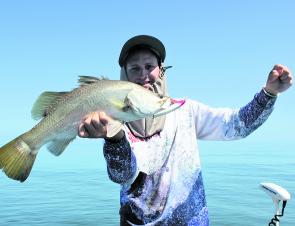
The author’s prize for taking the time to study the snags to decide which will likely be holding the desired fish.

An excellent example of headland snag structure which are ideally fished on large tides.
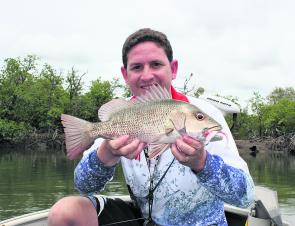
This prime specimen was taken from the crisscross style structure in the background. Jacks love this structure because it provides so much cover
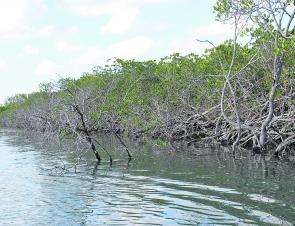
A perfect example of a tree like snag. Notice that the structure is lying off centre, which means the root system below will be creating a space for fish to hide.
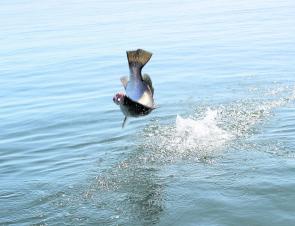
In typical barra fashion it takes flight soon after being hooked.

Lay down snags like this one are prime targets and running lures parallel to the fallen trunks will often bring fishy results.

This prime barra took a liking to a Gulp jerkbait strategically fished amongst the timber.
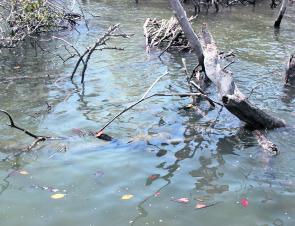
Crisscross snags like this one resemble a mess of sticks and roots and are a favourite for jacks, especially if they are submerged all tide.




